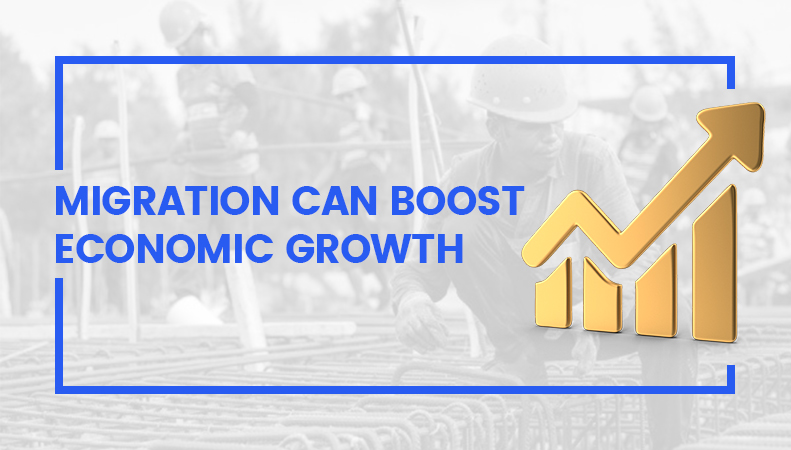
MIGRATION CAN BOOST ECONOMIC GROWTH
30th August 2022
Recently, e-wallet apps have been a migrant's best friend. A migrant is an umbrella term, not defined by international law, that describes a person who moves away from his or her usual abode, whether within a country or across an international border, for a variety of reasons, whether temporarily or permanently.
People who fall under this category include migrant labour, people whose specific movements are legally specified, such as smuggled migrants, and people whose status or mobility methods of movement are legally specified, such as smuggled migrants, and people whose status or methods of mobility are not expressly defined by international law, such as international students.
Human migration is the permanent change of residence of a person or a group; it excludes temporary movements such as nomadism, migrant labour, commuting, and tourism. Immigrants boost output and productivity in advanced economies in the short and medium run.
We show that increasing the intake of immigrants by one percentage point relative to total employment improves output by nearly 1% by the fifth year.
This is because both native and immigrant workers contribute a wide range of talents to the labour market, which complements each other and boosts production. Even slight increases in productivity as a result of immigration benefits natives' average income.
The favourable influence of productivity on refugee immigration to emerging markets and developing economies, on the other hand, is not noticeable. This highlights the challenges that these migrants experience while attempting to integrate into local labour markets.
What Drives People To Migrate?
1. Push And Pull Factors
The reasons why people leave a country are known as "push factors." The reasons they move to a specific
country are known as pull factors. Three basic variables push and pull people in different directions;
War, Jobs and Social reasons.
2. Socio-Political Factors
People may be forced to leave their country due to persecution based on their ethnicity, religion,
race, politics, or culture. Humanitarian refugees are more likely to flee armed conflict, human
rights violations, or persecution. This will have an impact on where they settle because some
countries are more permissive than others when it comes to humanitarian migrants.
People have been fleeing to Europe in significant numbers in recent years, fleeing violence, terror, and persecution at home. Over a quarter of the 295,800 asylum applicants given protection status in the EU in 2019 came from war-torn Syria, with Afghanistan and Iraq coming in second and third.
3. Demographic And Economic Factors
Growing or shrinking populations, as well as ageing or youthful populations, have an impact on economic
growth and job prospects in the nations of origin, as well as migration policies in the countries of
destination.
Labour standards, unemployment, and the overall health of a country's economy are all linked to demographic and economic migration. Higher earnings, greater job possibilities, a higher standard of living, and educational opportunities are all pull factors.
4. Environmental Factors
People have traditionally fled natural disasters such as floods, hurricanes, and earthquakes because of
the environment. Climate change, on the other hand, is projected to intensify extreme weather events,
implying that more people will be forced to relocate. "Environmental migrants," according to the
International Organization for Migration, "are those who are forced to leave their habitual homes,
either temporarily or permanently, due to sudden or progressive changes in the environment that adversely
affect their lives or living conditions, and who move either within their country or abroad."
What Is The Economical Impact Of Migration?
Economic growth is influenced by both direct and indirect consequences of international migration. There is little question that where migration increases the workforce, overall GDP will rise.
First, migration has a demographic impact, not only by increasing the size of the population but also by changing the age pyramid of receiving countries. The estimated net fiscal impact of immigrants, with and without the pension system and per-capita allocation of collectively accrued revenue and expenditure items.
Migrants, in comparison to natives, are more concentrated in the younger and economically active age groups, contributing to lower dependency ratios.
Second, migrants bring talents and competencies with them, adding to the host country's human capital supply. Migrants bring skills with them and contribute to the development of human capital in receiving countries. Migrants contribute to technological advancement as well.
The Future Of Migration
Rapid urbanisation in the developing world is projected to put additional strain on government capacity and contribute to rising emigration pressures during the next two decades, as cities provide more knowledge and connections to the outside world.
According to UN estimates, growing populations and internal migration will result in 1.6 billion extra urban dwellers by 2040, with roughly 80% of this urban growth occurring in nations that are least prepared to provide improved living standards. As a result, many new city residents would endure endemic poverty and restricted access to food, water, and sanitation, heightening the desire to relocate.
High rates of urbanisation have already resulted in the fast growth of informal settlements throughout the developing globe. Slums accounted for about two-thirds of the urban population in Sub-Saharan Africa as of 2018.
High unemployment, terrible living conditions, and low to serious levels of offences and even to violent crimes are common socioeconomic realities in large slum populations, typically as a result of a lack of possibilities in the city's formal environment.
Increases in emigration can be aided by urbanisation since it provides more people with access to the resources and networks required for international mobility. China's fast-growing metropolitan provinces produced much more overseas migrants than the country's rural areas between 1982 and 2000.
Climate change and environmental degradation are projected to exacerbate the economic and social stresses that induce migration in the future decades.
The people most vulnerable to harmful climatic consequences live in underdeveloped countries, yet they often lack the financial means to travel far beyond their boundaries, implying that climate change will mostly force migrants to neighbouring countries.
Warming temperatures, increasing sea levels, and harsh weather will all contribute to environmental deterioration, which will jeopardise livelihoods and may encourage migration from underdeveloped countries. Climate change is already making farming, fishing, and herding unsustainable in some of the world's most vulnerable locations.
Because their inhabitants have little room to withdraw from rising waters, small countries, particularly island states and those with lengthy coasts, are vulnerable to climate-induced migration.
Kiribati's government, for example, has pushed inhabitants to consider moving abroad to avoid the expected impacts of climate change, partially to attract world attention to Pacific island governments' vulnerability.
In the medium future, more frequent and destructive tropical storms are expected to relocate populations within countries, as those affected by the devastation will have limited options for moving outside. However, the long-term effects of destructive storms, such as slow and steady drops in GDP development, may lead some people to flee to neighbouring nations.
Opportunities For Migrants To Have Better Lives
Because of significant income gaps between locations, particularly countries, people are nevertheless encouraged to move to escape poverty. For sending countries, there are a variety of potential benefits of migration.
Migration allows households to overcome a shortage of finance and buffer the risks involved with investing in more productive activities through remittances, and it can also operate as a coping technique in times of crisis through remittances. Remittances can be used for both investments and household expenditures, such as housing and education.
In addition, new skills and education can be gained in the destination country and then transferred back to the home country.
Although migration boosts income and generally reduces poverty, the poor have different migration opportunities: there are fewer migrants among the poor, and often migrate to 'cheaper' destinations with lower returns. Emigration is difficult for the poor due to a lack of possibilities and prohibitive prices.
This equates to decreased profits and, most likely, a poverty reduction. Because of this cyclical interconnectivity, the poverty-reduction potential of migration for developing nations is frequently underutilised.
EVOLET is a digital wallet app for migrant workers.
Learn more at https://evolet.io/
